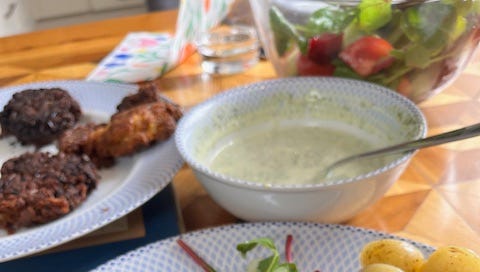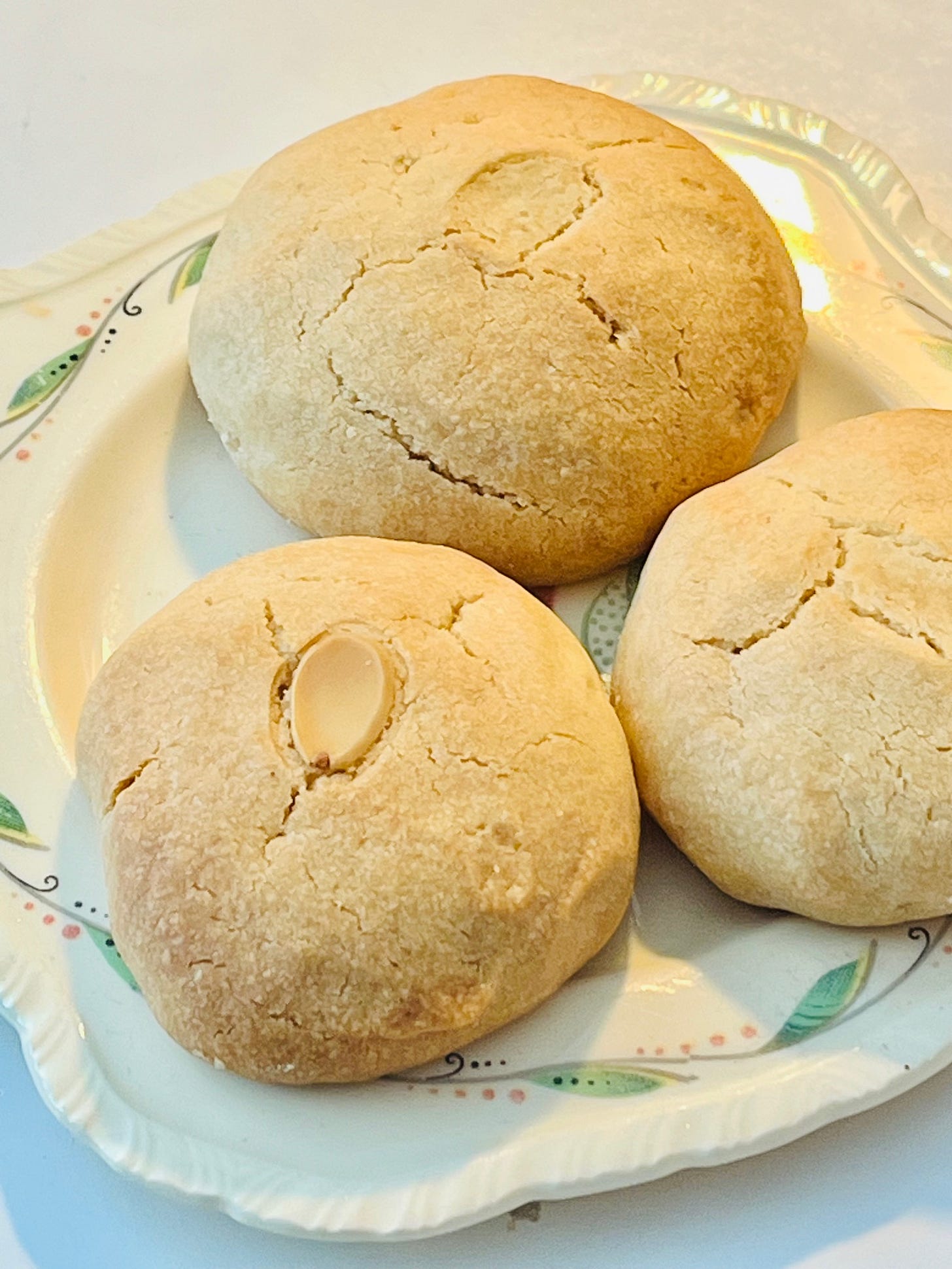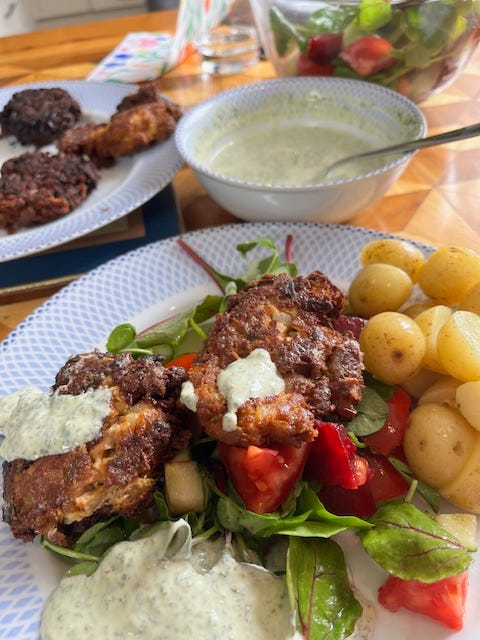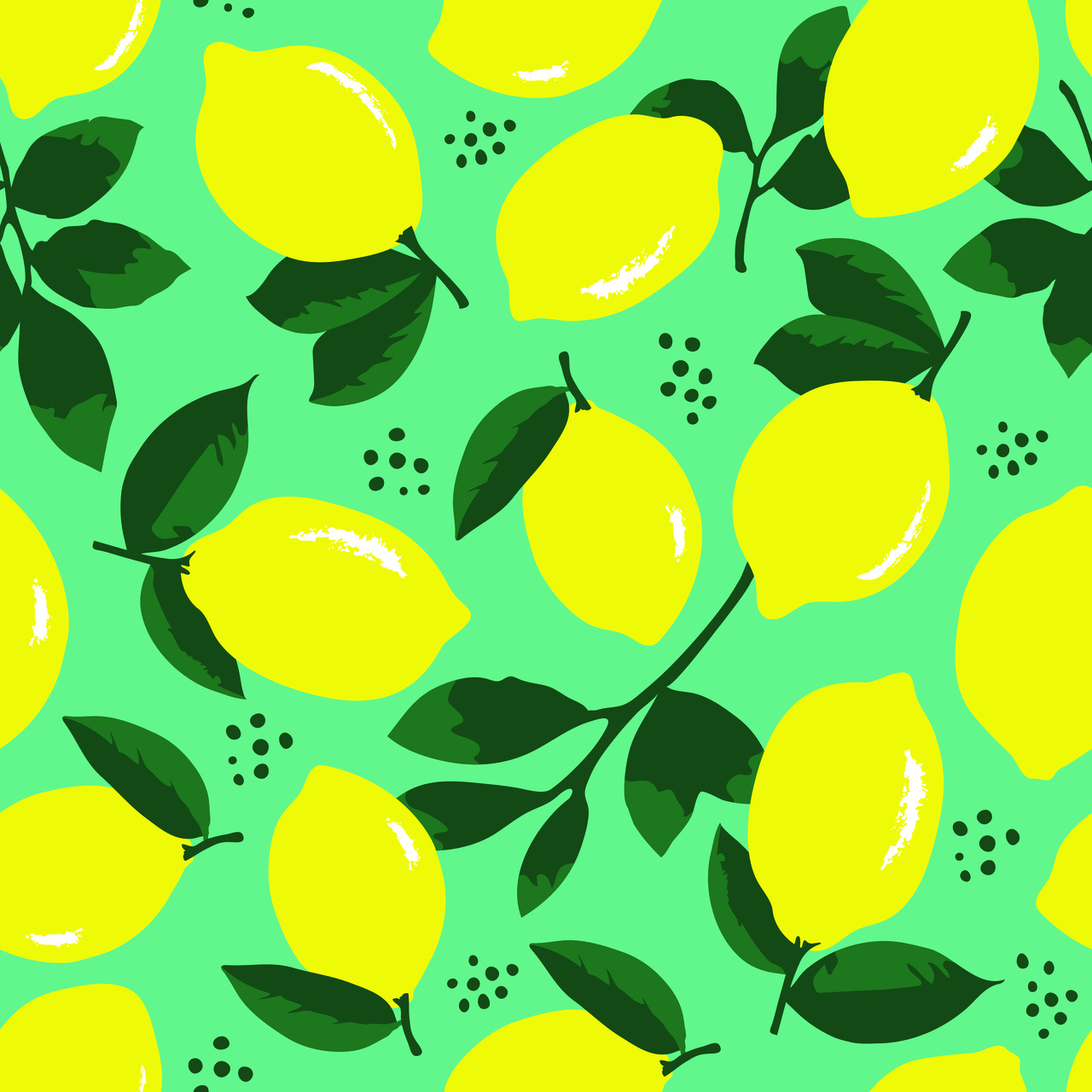Hello Lemonistas,
Welcome to the latest edition of The Lemon Grove newsletter. First up in this edition are some pictures from my veg garden and kitchen. As one family member once said, it seems that everything you are growing can be eaten (foraging aside). With two cherry trees, a couple of pear trees and a fig, alongside (this year) runner beans, mammoth red mangelwurzels, courgettes, tomatoes, blueberries, gooseberries and a few others to flavour (lavender) and for salad decoration (sweet pea petals), he had a point. Combined, my front and back gardens are a little shy of the size of half a tennis court. But, like for so many of us, it’s a haven where we can drink coffee, pluck blueberries fresh from the bush and feel achievement through weeding before breakfast.
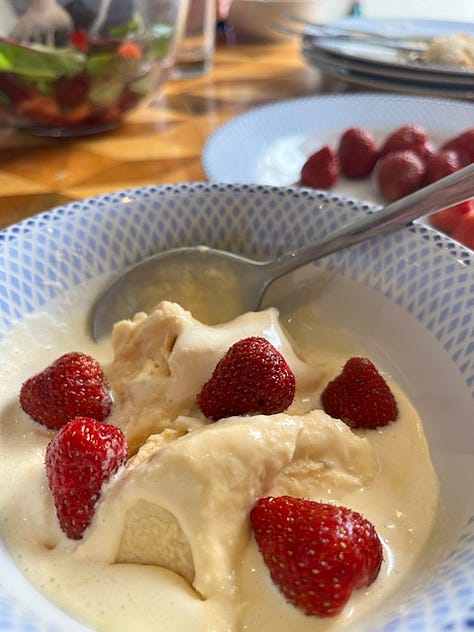
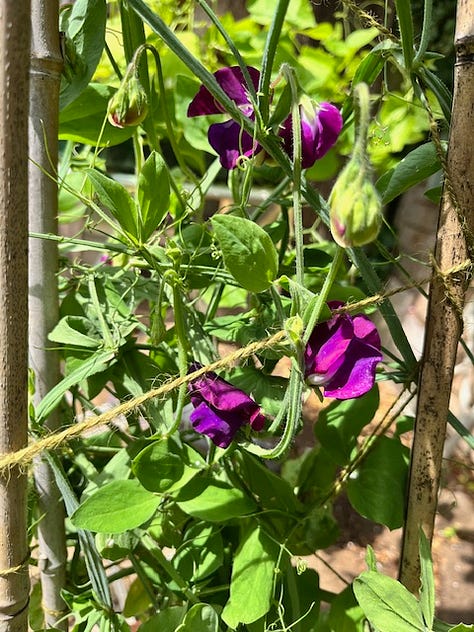
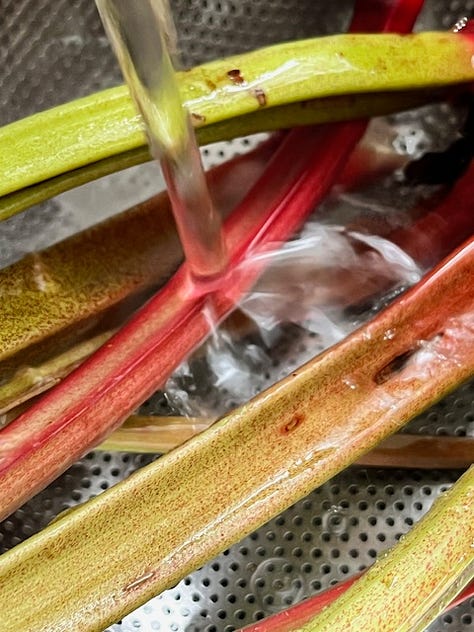
Elsewhere, I offer recipes from Lina Saad and Shahnaz Ahsan, who kindly shared these dishes, which are commonly eaten during the Muslim celebration of Eid al Adha, but can be enjoyed anytime.
And finally, there are some suggestions for you to read, watch, and a promo for the first Aylesford Food Festival, where I’ll be hosting the cooking theatre stage throughout the final weekend of June.
Tuna cakes and buttery biscuits
Over a recent Zoom, a group of Guild of Food Writers members watched, enjoyed and posed questions to Lina Saad and Shahnaz Ahsan about different food traditions behind one of the most important feasts in the Muslim calendar: Eid Al Adha (which this runs from June 5 - June 9), and their lives in London and Zimbabwe, respectively. Both are respected chefs and food writers and kindly agreed to share their recipes with readers of The Lemon Grove.
For more on Lina Saad
About Lina … Author profile
Cookbook … Ramadan Express
Instagram … A Lebanese Chef
You Tube … Lina’s Good Food
For more on Shahnaz Ahsan
About Shahnaz …Website
Substack newsletter … Scribbles and Dribbles
Cookbook (pre-orders) … The Jackfruit Chronicles
Ghraibi or Sanyura, by Lina Saad
Lina spent her childhood in Sierra Leone and Lebanon, before studying Hotel Management at London’s Westminster College and setting up Alicia restaurant on London’s Warren Street.
She introduces this recipe saying: ‘Long ago, in the heart of the old city of Saida in southern Lebanon, a peculiar little pastry made its quiet entrance to the world. It was pale, delicate, and melted in the mouth like snow on the tongue. People called it Ghraibi from the Arabic word Gharib, meaning “strange”– for it wasn’t like anything else. Made with nothing more than flour, icing sugar, and a touch of rich ghee, it was simple yet curious, fragile yet unforgettable.
250 gm unsalted butter (room temperature)
125 gm icing sugar (sifted)
350 gm plain flour (sifted)
2 tbsp, cooled ghee
Pinch of salt
Optional: blanched almonds or pistachios for decoration
Cream the butter and sugar: in a large bowl, beat the butter until soft and creamy.
Add the icing sugar and beat again until the mixture is light and fluffy.
Add the flour: gradually add the sifted flour and a pinch of salt. Mix until a soft, smooth dough forms. Add the ghee and knead for between 5-10 minutes. It should hold together without cracking, but not be sticky.
Rest the dough (Optional): wrap the dough in cling film and let it rest in the fridge for 20–30 minutes. This helps with shaping.
Shape the Ghraiba: pre-heat your oven to 180°C (320°F), fan setting if available. Take small portions of the dough and roll into smooth balls (about walnut-sized). Flatten slightly and place on a lined baking tray. Gently press a blanched almond or pistachio into the centre of each one, if using.
Bake: bake in the preheated oven for about 12–15 minutes. They should remain pale and not brown—just firm and slightly golden at the bottom.
Cool and serve: Let them cool completely on the tray—they’re very delicate while warm. Once cool, store in an airtight container. They stay fresh for several days.
Maach Bora, by Shahnaz Ahsan
Tuna Cakes with Mint Yoghurt Dip
Makes about 8–10 cakes
Shahnaz is an author, columnist and award-winning food writer. Her new book, ‘The Jackfruit Chronicles: Memories and Recipes from a British-Bangladeshi Kitchen’, will be published in July 2025 by Harper North. You’ll find this and many other recipes in Shahnaz’s book.
She introduces this recipe saying: These crunchy cakes can be served as appetisers or snacks, or as part of a main meal with rice when paired with dal (page 26) and a vegetable dish. I also love squashing leftover tuna cakes into a pitta and drizzling over the yoghurt dip. The key to this recipe is to ensure that the tuna is very well drained, as any excess liquid will result in a sloppy mixture that won’t hold together when frying. It’s also important that the onions and coriander are very finely chopped so the mixture is almost like a thick paste.
For the tuna cakes
2 x 145g tins of tuna in oil, very well drained
1 tsp salt
1 tsp ground turmeric
½ tsp chilli powder (optional)
1 small white onion (about 110g) very finely chopped
1 small bunch of coriander, very finely chopped
2 green or red chillies, finely chopped
1 tbsp chickpea (gram) flour
1 large egg, beaten
Sunflower oil, for frying
For the yoghurt dip
50 gm fresh coriander
50 gm fresh mint
Juice of 1 lime
½ green chilli (optional), finely diced
150 gm Greek yoghurt
Place the tuna in a sieve and squeeze out any excess liquid with your hands. Add the drained tuna to a large mixing bowl and add the salt, turmeric, and chilli powder (if using), and mix by hand until the tuna breaks down into very small pieces. It should almost resemble the texture of coarse breadcrumbs. Add the onions, coriander and fresh chilli and continue mixing, ensuring the ingredients are well combined – the mixture should become softer and finer as you work it.
Finally, add the chickpea flour and beaten egg and continue to knead until the mixture is almost like a paste and forms a single large ball that is moist but not wet. If it seems as if the mixture isn’t holding together quite well enough, you can add in a little more beaten egg. (If you are making this ahead, you can place the mixture into a lidded container and store it in the fridge at this point. Take the mixture out of the fridge half an hour before cooking and let it come to room temperature.)
Divide the mixture into small, golf ball-sized pieces and press down on each one until it is formed into a flat cutlet, or patty shape, around 1cm thick. Make sure that the edges of each flattened piece are smooth. Heat a few tablespoons of sunflower oil – don’t be shy with the amount – in a non-stick frying pan over a medium heat. Test the heat of the pan by dropping in a tiny piece of the mixture – if it sizzles and starts to turn golden, it is hot enough. Place the shaped cutlets carefully into the pan and fry for 2–3 minutes on each side until golden brown and crunchy.
To make the yoghurt: in a blender, whizz the herbs, lime juice, and chilli (if using) until they form a purée. In a bowl, add the yoghurt and beat together with one heaped teaspoon of the purée and season with salt. You can add more purée to taste – any unused purée will keep refrigerated in an airtight container for up to five days; try it drizzled over roasted vegetables or fish.
READ: Popcorn Lung
Visit iGlobe News, where you’ll find my article looking at vaping and whether popcorn lung is killing people who use this tobacco alternative.
LISTEN: MAD Food Symposium, Copenhagen
Copenhagen hosted the Rene Redzepi/ Noma MAD Symposium recently, uniting chefs, farmers, producers and restaurateurs under the theme ‘Build to Last’. Listen to a short report by Monocle magazine and featuring some serious food makers, thinkers and activists including Thomas Keller (French Laundry, California); Yves Chouinard of outdoor clothing company Pattagonia; Ron Finley, the ‘gangsta;’ gardener transforming south-central Los Angeles, and José Andres, the chef turned activist whose World Central Kitchen serves meals in area of war and natural disaster where governments are in trouble or failing and have or are working in places such as Ukraine, Gaza, Haiti, Lebananon and Sudan.
Click HERE to listen.
WATCH: Carême, Apple TV+
Carême on Apple TV+ is another cinematic feast for the senses, in the shadow of the film The Taste of Things. Centred around an early celebrity chef who defined French cuisine, Marie-Antoine Carême, this series serves up drama with a side of soufflé.
Carême is a historical French-language drama series about the complex life and rise of a humble cook to becoming the world's first celebrity chef. It’s set during the Napoleonic era. Lighting, attractive actors and some racy foodie scenes benefit from effective cinematography. Even the stews, piles of to-be peeled onions and patisserie have better lighting than most influencers. Every scene is bathed in the warm glow of candlelight and culinary ambition, like MasterChef met Downton Abbey and they had a deliciously broody baby. The atmosphere is rich with powdered wigs, pastry dough, and the constant threat of under-seasoning. As for the script, it’s sharp, witty, and sprinkled with just enough sass to keep things from boiling over. Think historical drama but with more crème brûlée and fewer sword fights.
WATCH: Aylesford Food Festival
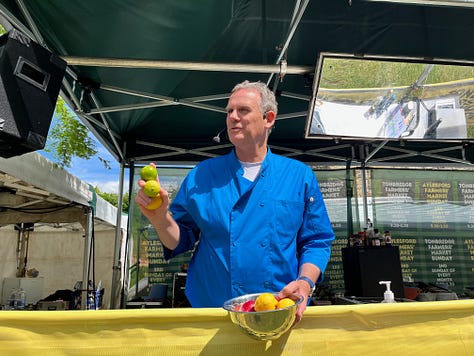


On the final weekend of this month, I’ll be cooking with local and seasonal ingredients, sharing food prep, tasting notes and recipes, and interviewing local producers and chefs at the First Aylesford Food & Drink Festival. As host and cook, I’ll be on stage from 11 am - 6 pm, so come down and say hello.
The event is being held in the beautiful grounds of Aylesford Priory.
Saturday, June 28 & Sunday, June 29. Entrance is free. Click here for more information. Aylesford Priory. Free parking.
The Lemon Grove's Substack newsletter
Give the gift of a 'The Lemon Grove' Substack newsletter to a friend, family member or yourself! Organise your gift through this link below … Thank you.
If you enjoyed this post, please click on the little ❤️ below ⬇️.
If you haven’t already downloaded the Substack App, I encourage you to do so.
The app is how you’ll access the full value and experience of your subscription to The Lemon Grove.
Thanks for reading and please do leave a comment, by pressing the button below!
Bruce McMichael
Writer, Podcaster, Event Host & Cook, Lemonista
Email: hello@thelemongrove.net
Facebook: LemonGroveSocial
Instagram: LemonGrovePics

